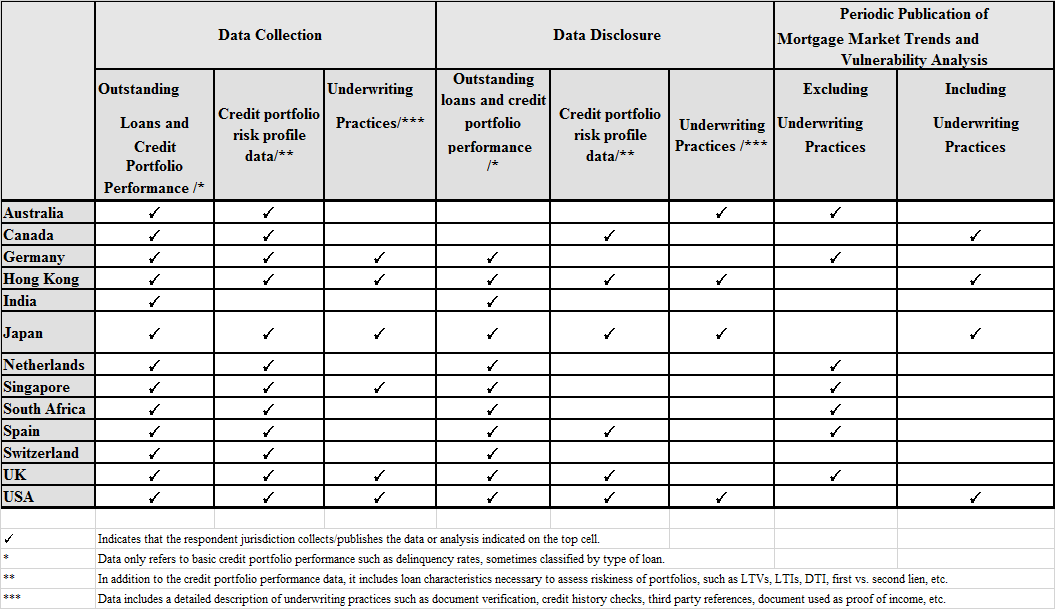
By Martin North, cross-posted from the Digital Finance Analytics Blog
Often when we raise comparative issues between mortgage industry practices in Australia and overseas, we find that people leap to the defence of the Australian market, as world’s best practice. So today I wanted to highlight gaps which exist in the Australian market environment, and suggest that there is indeed room for improvement, according to recent global research.
To do this, I refer back to the Financial Stability Review documentation on mortgage industry practice. It is a valuable resource, containing peer review data and recommended best practices. One table in the Thematic Review of Mortgage Underwriting and Origination Practices from 18 March 2011 caught my attention.
“As the global crisis showed, the consequences of weak underwriting practices in one country can be transferred globally through securitisation of mortgages underwritten to weak standards. Thus, it is important to have sound residential mortgage underwriting practices at the point at which a mortgage loan is originally made. Internationally agreed principles that build on the Joint Forum recommendations could help to strengthen residential mortgage underwriting practices, and the peer review draws lessons from current practices to illustrate some potential principles that could guide future standard-setting. However, given that the underlying risks can differ across jurisdictions and within countries, the findings of the review suggest that such principles would best be high-level rather than aimed at detailed international standards”
On Annex B.7 page 64, they outline a review of data collection and disclosure practices across 23 countries, including Australia. Here is a summary version, from which I removed some of the less significant members:
 The assessment covers the collection of relevant data, the disclosure of relevant data and the publication of relevant data for trend analysis. Australia seems to have s significant blind spot relating to underwriting practices. We do not collect data from lenders at a detailed level relating to underwriting practices; we do not disclose data on outstanding loans and credit portfolio performance, or credit risk portfolio data, and we do not publish trend data on underwriting practices. The UK, US and Japan have significantly more sophistication in their data capture and reporting, so why is Australia not doing the same?
The assessment covers the collection of relevant data, the disclosure of relevant data and the publication of relevant data for trend analysis. Australia seems to have s significant blind spot relating to underwriting practices. We do not collect data from lenders at a detailed level relating to underwriting practices; we do not disclose data on outstanding loans and credit portfolio performance, or credit risk portfolio data, and we do not publish trend data on underwriting practices. The UK, US and Japan have significantly more sophistication in their data capture and reporting, so why is Australia not doing the same?
Some will say, we do not need to, because our loss rates are low. Others will say its confidential data which the banks should not disclose because it would be commercial in confidence. I expect someone will also cite the cost of data collection. But I am left with the distinct impression there is a gap which should be filled, especially as we are seeing LVR’s rising, and the property market displaying bubble like behaviour.
One other insight relates to their views of sound practice, as outlined in the FSB report Principles of Sound Residential Mortgage Underwriting Pracitces 2012.
6.2 Jurisdictions should ensure that lenders consider more conservative underwriting criteria to compensate for situations where the underlying risks are higher. For example, more conservative underwriting standards (e.g. LTV ratios or servicing requirements) could be considered where:
- there are considerable risks that an asset price bubble is building up in the property market as a whole or in specific segments or geographical areas;
- the loan is in a market segment that, compared with other mortgage loans in that jurisdiction, tends to perform worse than average in a property downturn (depending on the jurisdiction, examples of such a market segment might include luxury apartments, buy-to-let investors, second homes, cash-out refinancers, etc.);
- there is a lack of full recourse against borrowers; or
- other aspects of the underwriting standards are looser than the typical setting in the jurisdiction.
I agree, so where are the local regulatory interventions in the current environment in Australia? Oh, I forget, the RBA says everything is fine!

